INSTITUT SUPERIEUR D'ANTHROPOLOGIE
INSTITUTE OF ANTHROPOLOGY
ONLINE COURSES / COURS A DISTANCE
FALL TERM : OCTOBER 2014
REGISTER NOW
GRECE – 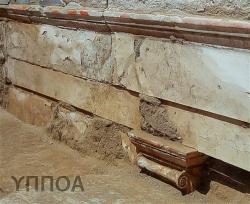
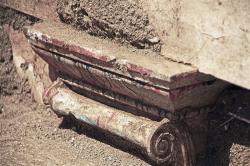 Amphipolis - What lies beneath the sphinxes at Amphipolis? Researchers keep digging, revealing details of the gate lintel the sphinxes step on. Archaeologists working at Amphipolis led by Katerina Peristeri managed to reveal the upper part of the lintel the now famous Kasta Mound sphinxes step on. The lintel was found following the removal of five blocks from the protective wall sealing what is believed to be the monumental tomb’s main doorway. As with the sphinxes, the lintel is also marble, covered in fresco imitating an Ionic architrave, which bears decoration in red, blue and black. Straight under the Ionic architrave, two Ionic pillar capitals belonging to the doorjambs, also frescoed and decorated in the same colours, have been revealed. At the same time, debris from beneath the sphinxes has been removed. The works are to continue by supporting the finds.
Amphipolis - What lies beneath the sphinxes at Amphipolis? Researchers keep digging, revealing details of the gate lintel the sphinxes step on. Archaeologists working at Amphipolis led by Katerina Peristeri managed to reveal the upper part of the lintel the now famous Kasta Mound sphinxes step on. The lintel was found following the removal of five blocks from the protective wall sealing what is believed to be the monumental tomb’s main doorway. As with the sphinxes, the lintel is also marble, covered in fresco imitating an Ionic architrave, which bears decoration in red, blue and black. Straight under the Ionic architrave, two Ionic pillar capitals belonging to the doorjambs, also frescoed and decorated in the same colours, have been revealed. At the same time, debris from beneath the sphinxes has been removed. The works are to continue by supporting the finds.
http://www.archaiologia.gr/en/
ROYAUME UNI – 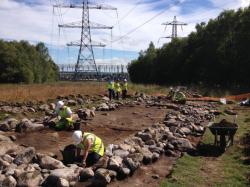 Leylodge - Archaeologists have uncovered the remains of a “nationally significant” medieval farm building near an electrical substation in Aberdeenshire. The barn, which dates back to the 14th or 15th century, was discovered at Leylodge, Kintore, while excavators carried out surveys on behalf of Scottish Hydro Electric (SHE) Transmission. Several objects have been discovered during previous surveys across Scotland. But the team said that the floor deposits and numerous pieces of pottery found on this occasion would give historians vital clues about medieval farm living. Bruce Mann, an archaeologist with Aberdeenshire Council, said the discovery would help explore what farming life was really like. “Rural buildings from this period are extremely rare in Scotland, and to be able to properly investigate one through archaeological excavation will help us hugely in understanding farming life at this time,” he said.
Leylodge - Archaeologists have uncovered the remains of a “nationally significant” medieval farm building near an electrical substation in Aberdeenshire. The barn, which dates back to the 14th or 15th century, was discovered at Leylodge, Kintore, while excavators carried out surveys on behalf of Scottish Hydro Electric (SHE) Transmission. Several objects have been discovered during previous surveys across Scotland. But the team said that the floor deposits and numerous pieces of pottery found on this occasion would give historians vital clues about medieval farm living. Bruce Mann, an archaeologist with Aberdeenshire Council, said the discovery would help explore what farming life was really like. “Rural buildings from this period are extremely rare in Scotland, and to be able to properly investigate one through archaeological excavation will help us hugely in understanding farming life at this time,” he said.
https://www.pressandjournal.co.uk/fp/news/aberdeenshire/322794/medieval-farm-building-uncovered-at-shire-substation/
ROYAUME UNI –  Manchester - Ground investigations carried out along the alignment of the tram route on Cross Street found the remains of over 100 people, interred 150 to 200 years ago and affiliated to the Unitarian Church.Dr Andrew Myers, said: “Historically, the growth of industrial Manchester in the late eighteenth and nineteenth centuries is a story of global significance. “The archaeological investigation and recording of the Cross Street Chapel burials provides a rare opportunity. “We can learn directly from the remains of individuals who were part of the non-conformist movement in Manchester, which played a key role promoting awareness of the conditions in which working populations were living and in campaigns for social reforms.”
Manchester - Ground investigations carried out along the alignment of the tram route on Cross Street found the remains of over 100 people, interred 150 to 200 years ago and affiliated to the Unitarian Church.Dr Andrew Myers, said: “Historically, the growth of industrial Manchester in the late eighteenth and nineteenth centuries is a story of global significance. “The archaeological investigation and recording of the Cross Street Chapel burials provides a rare opportunity. “We can learn directly from the remains of individuals who were part of the non-conformist movement in Manchester, which played a key role promoting awareness of the conditions in which working populations were living and in campaigns for social reforms.”
http://www.manchesterconfidential.co.uk/News/Archaelogical-Metrolink-Project-Underway
BULGARIE – 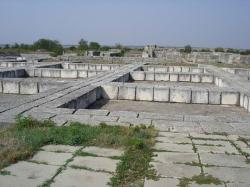
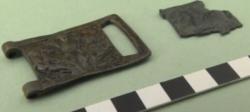 Pliska - Pliska, which boasts a large archaeological reserve and is the subject of ongoing digs, is best known as having been the capital of the First Bulgarian Kingdom from 681 to 893CE. According to a report on August 22 2014 by public broadcaster Bulgarian National Television, the finds date back about 1100 years. They were found in part of the palace complex of the first Bulgarian capital. The find of the buckles with the imperial symbols is extremely rare for Pliska in spite of the former capital’s lively contacts with the Byzantine empire. Archaeologist Andrei Aladzhov said that the two finds were bronze belt buckles from the 10th century. One had an image of the mythical Gryphon and the other depicts the ascension of Alexander, borne into the sky in a chariot pulled by four horses. The place where the find was made is in the north-western part of the stone arena where in the past there was a huge wooden platform in the shape of a hemisphere. Behind that was another wooden building which archaeologists are exploring further. Aladzhov said that the building attached to the stands was seen as being likely to have been a room to prepare those who were coming out to perform in the arena. The medieval stone arena or theatre had an important place in the city plan of Pliska. It is close to the ruler’s palace and administrative buildings of the former capital city.
Pliska - Pliska, which boasts a large archaeological reserve and is the subject of ongoing digs, is best known as having been the capital of the First Bulgarian Kingdom from 681 to 893CE. According to a report on August 22 2014 by public broadcaster Bulgarian National Television, the finds date back about 1100 years. They were found in part of the palace complex of the first Bulgarian capital. The find of the buckles with the imperial symbols is extremely rare for Pliska in spite of the former capital’s lively contacts with the Byzantine empire. Archaeologist Andrei Aladzhov said that the two finds were bronze belt buckles from the 10th century. One had an image of the mythical Gryphon and the other depicts the ascension of Alexander, borne into the sky in a chariot pulled by four horses. The place where the find was made is in the north-western part of the stone arena where in the past there was a huge wooden platform in the shape of a hemisphere. Behind that was another wooden building which archaeologists are exploring further. Aladzhov said that the building attached to the stands was seen as being likely to have been a room to prepare those who were coming out to perform in the arena. The medieval stone arena or theatre had an important place in the city plan of Pliska. It is close to the ruler’s palace and administrative buildings of the former capital city.
http://sofiaglobe.com/2014/08/22/archaeology-10th-century-buckles-with-imperial-symbols-found-in-bulgarias-pliska/
USA –  Dillard - Our story begins at the Dillard site, which is being excavated by Crow Canyon on the Indian Camp Ranch subdivision. The story, which has been pieced together over three years of excavation, tells a tale that began 1,500 years ago 5 feet down inside a great kiva. The kiva, which measures 33 feet across and 5 feet deep, is the oldest great kiva in the northern Mesa Verde region. “This is when people decided to go full-blown agriculture,” Sommers said. “This right here is our story. We are still an agrarian society today.” The Dillard site tends to get archaeologists very excited because it is a Basketmaker III site, a period during which ancestral Pueblo people made a shift from hunting and gathering to agriculture. Large communities started to form, and pottery was introduced. The Basketmaker III Period Time period: A.D. 500-750 It was a pivotal time in Pueblo history, one that saw the introduction of pottery, the bow and arrow and cultivated beans (corn and squash had already been introduced during the earlier Basketmaker II and late Archaic periods). In the Mesa Verde region, the Basketmaker III perriod was also a time of rapid population growth, which archaeologists believe was largely the result of immigration into the area. Where the immigrants came from remains the subject of much research and debate.
Dillard - Our story begins at the Dillard site, which is being excavated by Crow Canyon on the Indian Camp Ranch subdivision. The story, which has been pieced together over three years of excavation, tells a tale that began 1,500 years ago 5 feet down inside a great kiva. The kiva, which measures 33 feet across and 5 feet deep, is the oldest great kiva in the northern Mesa Verde region. “This is when people decided to go full-blown agriculture,” Sommers said. “This right here is our story. We are still an agrarian society today.” The Dillard site tends to get archaeologists very excited because it is a Basketmaker III site, a period during which ancestral Pueblo people made a shift from hunting and gathering to agriculture. Large communities started to form, and pottery was introduced. The Basketmaker III Period Time period: A.D. 500-750 It was a pivotal time in Pueblo history, one that saw the introduction of pottery, the bow and arrow and cultivated beans (corn and squash had already been introduced during the earlier Basketmaker II and late Archaic periods). In the Mesa Verde region, the Basketmaker III perriod was also a time of rapid population growth, which archaeologists believe was largely the result of immigration into the area. Where the immigrants came from remains the subject of much research and debate.
http://www.cortezjournal.com/article/20140821/NEWS01/140829924/PBS-Time-Team-features-local-ruins-
ROYAUME UNI – 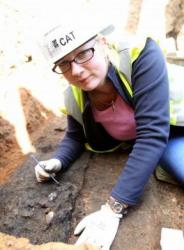 Colchester - Archaeologists have found evidence of food bought by Romans before they were massacred by Boadicea's armies. The Warrior Queen's forces razed Colchester to the ground, destroying everything in their path. But the severity of the fire also preserved parts of it – parts which have now been unearthed by Colchester archaeologists. Time teams excavating behind Williams&Griffin, in Colchester High Street, have discovered all manner of historical treasures, including a major public building, jewellery, pots and human remains. And they have now found food that was never eaten. Dates, figs, wheat and what are thought to be peas, were all found on a shelf in the kitchen of a Roman home.
Colchester - Archaeologists have found evidence of food bought by Romans before they were massacred by Boadicea's armies. The Warrior Queen's forces razed Colchester to the ground, destroying everything in their path. But the severity of the fire also preserved parts of it – parts which have now been unearthed by Colchester archaeologists. Time teams excavating behind Williams&Griffin, in Colchester High Street, have discovered all manner of historical treasures, including a major public building, jewellery, pots and human remains. And they have now found food that was never eaten. Dates, figs, wheat and what are thought to be peas, were all found on a shelf in the kitchen of a Roman home.
http://www.gazette-news.co.uk/news/local/11428327._/?
ROYAUME UNI – 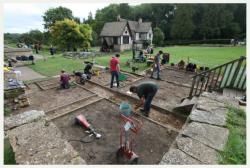
 Chedworth - The two-week project at Chedworth Roman Villa has unearthed a mosaic which has taken all-involved by surprise. In charge of the excavation, National Trust archaeologist, Dr Martin Papworth said: “This is a brand new, unknown mosaic. “The excavation site, which we are working on, had been excavated by the late Sir Ian Richmond in the 1960s, and he had not recorded any mosaic floors during his work here.The mosaics which we have just uncovered might have been seen by Victorians in 1860s, but nobody living has seen them before the dig this week.” The mosaic comes from a grand Roman reception room in the north wing of the villa in Yanworth. Its discovery allows the archaeologists to form a better picture of the scale of the room.
Chedworth - The two-week project at Chedworth Roman Villa has unearthed a mosaic which has taken all-involved by surprise. In charge of the excavation, National Trust archaeologist, Dr Martin Papworth said: “This is a brand new, unknown mosaic. “The excavation site, which we are working on, had been excavated by the late Sir Ian Richmond in the 1960s, and he had not recorded any mosaic floors during his work here.The mosaics which we have just uncovered might have been seen by Victorians in 1860s, but nobody living has seen them before the dig this week.” The mosaic comes from a grand Roman reception room in the north wing of the villa in Yanworth. Its discovery allows the archaeologists to form a better picture of the scale of the room.
http://www.gloucestershireecho.co.uk/Roman-mosaic-uncovered-archeologists-Chedworth/story-22804162-detail/story.html?